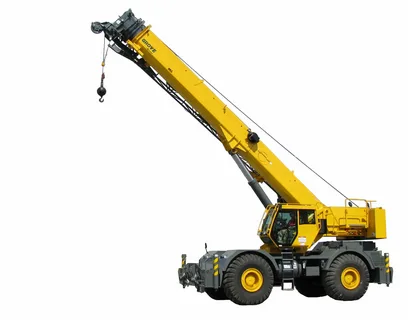
The mobile crane market is expected to experience a year-on-year growth of 6.7% in 2024, reaching a market value of USD 17,679.6 million. This upward trend is projected to continue with a Compound Annual Growth Rate (CAGR) of 6.7% from 2024 to 2034, with market revenues anticipated to climb to USD 33,500.2 million by the end of 2034.
Mobile cranes are essential across various industries, providing exceptional versatility and mobility for lifting and transporting heavy equipment and materials. The global mobile cranes market is poised for significant growth, driven by several key factors. Let’s explore the forces propelling this market forward, the promising opportunities it presents, and the trends that are shaping its future.
Market Drivers:
- Infrastructure Development Boom: The ongoing surge in infrastructure projects worldwide, including roads, bridges, and renewable energy installations, necessitates the use of mobile cranes for efficient construction and installation.
- Urbanization and Industrial Growth: Rapid urbanization and industrial expansion create a demand for mobile cranes in construction, manufacturing, and plant maintenance activities.
- Focus on Renewable Energy: The growing adoption of wind turbines and solar power plants fuels the demand for specialized mobile cranes capable of handling large and heavy components.
- Advancements in Technology: Innovations in areas like telematics, automation, and improved lifting capacities are enhancing efficiency, safety, and operational capabilities of mobile cranes.
Full Market Assessment: Comprehensive Report
Opportunities Abound:
The mobile crane market presents a wealth of opportunities for manufacturers and solution providers:
- Focus on Niche Applications: Developing specialized mobile cranes for specific industries, such as all-terrain cranes for construction sites with uneven terrain or compact cranes for tight indoor spaces, can attract new customer segments.
- Integration with Advanced Technologies: Equipping cranes with features like load sensing, anti-collision systems, and remote monitoring capabilities can enhance safety, optimize lifting operations, and improve data-driven decision making.
- Emphasis on Rental Services: Offering mobile cranes as a service with comprehensive maintenance and support packages can cater to projects with short-term lifting needs.
- Focus on Emerging Markets: As infrastructure development accelerates in emerging economies, manufacturers can tap into these growing markets with cost-effective and reliable mobile crane solutions.
Future Trends:
The mobile crane market is expected to witness several key trends in the coming years:
- Rise of Electric and Hybrid Cranes: Focus on sustainability will drive the development of electric and hybrid mobile cranes with lower emissions and reduced dependence on fossil fuels.
- Emphasis on Data Analytics: Advanced data analytics capabilities can provide valuable insights into crane usage patterns, preventive maintenance needs, and operator performance, optimizing fleet management and utilization.
- Focus on Artificial Intelligence (AI): AI-powered systems can assist crane operators with tasks like load calculation, route planning, and collision avoidance, further enhancing safety and efficiency.
- Rise of the Sharing Economy: Peer-to-peer crane sharing platforms could emerge, connecting project owners with mobile crane owners for short-term rentals, increasing utilization rates and market access.
Leading Mobile Crane Brands
- Liebherr Group
- Terex Corporation
- Tadano Ltd.
- Zoomlion Heavy Industry Science and Technology Co., Ltd.
- XCMG Construction Machinery Co., Ltd.
- Sany Heavy Industry Co., Ltd.
- KATO WORKS CO., LTD.
- Kobelco Construction Machinery Co., Ltd.
- Hitachi Sumitomo Heavy Industries Construction Crane Co., Ltd.
- The Manitowoc Company, Inc.
- Konecranes
- PALFINGER AG
- Sarens n.v./s.a.
- Altec Industries
- Bauer Group
Key Segments of Market Report
By Product Type:
By product type, the sector is categorized into truck-mounted cranes, trailer-mounted cranes, and crawler cranes.
By Capacity:
In terms of capacity, the industry is classified into up to 10 tons, 11 to 50 tons, and above 50 tons.
By Propulsion:
The propulsion category is classified into internal combustion engine cranes and electric cranes.
By End-use:
Based on end-use, the sector is categorized into construction and mining, industrial, ports and shipping, utilities, oil and gas, transport and logistics, and others.
By Region:
The leading regions considered in the study include North America, Latin America, Western Europe, Eastern Europe, East Asia, South Asia & Pacific, and the Middle East and Africa.
About Future Market Insights (FMI)
Future Market Insights, Inc. (ESOMAR certified, recipient of the Stevie Award, and a member of the Greater New York Chamber of Commerce) offers profound insights into the driving factors that are boosting demand in the market. FMI stands as the leading global provider of market intelligence, advisory services, consulting, and events for the Packaging, Food and Beverage, Consumer, Technology, Healthcare, Industrial, and Chemicals markets. With a vast team of over 400 analysts worldwide, FMI provides global, regional, and local expertise on diverse domains and industry trends across more than 110 countries.
Contact Us:
Future Market Insights Inc.
Christiana Corporate, 200 Continental Drive,
Suite 401, Newark, Delaware – 19713, USA
T: +1-845-579-5705
For Sales Enquiries: sales@futuremarketinsights.com
Website: https://www.futuremarketinsights.com
LinkedIn| Twitter| Blogs | YouTube

